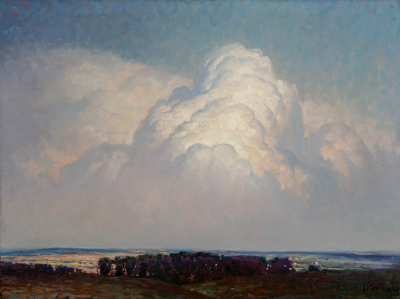George William Sotter
American, 1879 - 1953
George W. Sotter (1879–1953) is celebrated for his evocative depictions of Bucks County's landscapes, capturing its towns, farms, and valleys with remarkable sensitivity. A master of nocturnes, Sotter excelled at transforming dark scenes into luminous works, using moonlight to illuminate snow-covered vistas and sparkling waters, creating a warm and inviting atmosphere.
Born in Pittsburgh, Sotter began his artistic journey as a stained-glass apprentice before dedicating himself to landscape painting. His pivotal moment came in 1902 when he studied under Edward Redfield in Bucks County. This mentorship flourished into a lifelong friendship, shaping his artistic direction. After years of teaching at the Carnegie Institute of Technology, Sotter returned to Bucks County in 1919, where he established a successful stained-glass studio, employing up to fifteen craftsmen at a time.
Sotter's work is featured in prestigious collections, including the James A. Michener Art Museum and the Pennsylvania State Museum. Notably, he received the Silver Medal at the 1915 Panama-Pacific Exposition. His enchanting winter scenes, filled with glowing moonlight and quiet charm, remain his enduring legacy, encapsulating the serene beauty of rural Pennsylvania. He passed away in Holicong, leaving behind a rich artistic heritage.
Born in Pittsburgh, Sotter began his artistic journey as a stained-glass apprentice before dedicating himself to landscape painting. His pivotal moment came in 1902 when he studied under Edward Redfield in Bucks County. This mentorship flourished into a lifelong friendship, shaping his artistic direction. After years of teaching at the Carnegie Institute of Technology, Sotter returned to Bucks County in 1919, where he established a successful stained-glass studio, employing up to fifteen craftsmen at a time.
Sotter's work is featured in prestigious collections, including the James A. Michener Art Museum and the Pennsylvania State Museum. Notably, he received the Silver Medal at the 1915 Panama-Pacific Exposition. His enchanting winter scenes, filled with glowing moonlight and quiet charm, remain his enduring legacy, encapsulating the serene beauty of rural Pennsylvania. He passed away in Holicong, leaving behind a rich artistic heritage.
